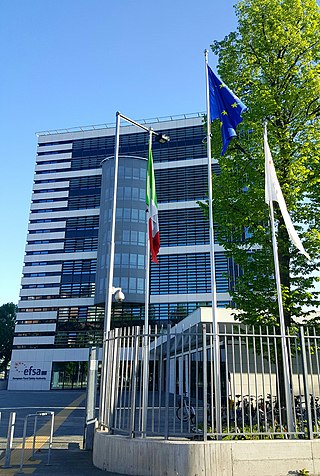EFSA is an acronym for:
EFSA is also the ICAO code for Savonlinna Airport.
EFSA is an acronym for:
EFSA is also the ICAO code for Savonlinna Airport.

A prune is a dried plum, most commonly from the European plum. Not all plum species or varieties can be dried into prunes. A prune is the firm-fleshed fruit (plum) of Prunus domestica varieties that have a high soluble solids content, and do not ferment during drying. Use of the term "prune" for fresh plums is obsolete except when applied to varieties of plum grown for drying.

Quinoline Yellow WS is a mixture of organic compounds derived from the dye Quinoline Yellow SS. Owing to the presence of sulfonate groups, the WS dyes are water-soluble (WS). It is a mixture of disulfonates (principally), monosulfonates and trisulfonates of 2-(2-quinolyl)indan-1,3-dione with a maximum absorption wavelength of 416 nm.p. 119

Sunset yellow FCF is a petroleum-derived orange azo dye with a pH dependent maximum absorption at about 480 nm at pH 1 and 443 nm at pH 13 with a shoulder at 500 nm. When added to foods sold in the United States it is known as FD&C Yellow 6; when sold in Europe, it is denoted by E Number E110.
Becel is a brand of margarine produced by Dutch company Upfield. In France, it is sold as Fruit D'or, and in the United States as Promise.
Butterfat or milkfat is the fatty portion of milk. Milk and cream are often sold according to the amount of butterfat they contain.

Erythrosine, also known as Red No. 3, is an organoiodine compound, specifically a derivative of fluorone. It is a pink dye which is primarily used for food coloring. It is the disodium salt of 2,4,5,7-tetraiodofluorescein. Its maximum absorbance is at 530 nm in an aqueous solution, and it is subject to photodegradation.

Ponceau 4R is a synthetic colourant that may be used as a food colouring. It is denoted by E Number E124. Its chemical name is 1-(4-sulfo-1-napthylazo)-2-napthol-6,8-disulfonic acid, trisodium salt. Ponceau is the generic name for a family of azo dyes.

Allura Red AC is a red azo dye that goes by several names, including FD&C Red 40. It is used as a food dye and has the E number E129.
Phosphated distarch phosphate, is a type of chemically modified starch. It can be derived from wheat starch, tapioca starch, potato starch or many other botanical sources of starch. It is produced by replacing the hydrogen bonds between starch chains by stronger, covalent phosphate bonds that are more permanent. It is manufactured by treating starch with sodium tripolyphosphate (STPP) and sodium trimetaphosphate (STMP), or phosphoric chloride (POCl3). Phosphorylated cross-linked starches is a category of modified food starches within the U.S. Code of Federal Regulations. Starches treated with STMP and STPP must not exceed 0.4 percent phosphorus as residual phosphate.

The European Food Safety Authority (EFSA) is the agency of the European Union (EU) that provides independent scientific advice and communicates on existing and emerging risks associated with the food chain. EFSA was established in February 2002, is based in Parma, Italy, and for 2021 it has a budget of €118.6 million, and a total staff of 542.
Calcium citrate malate is a water-soluble calcium supplement. It is the calcium salt of citric acid and malic acid with variable composition.
The artificial sweetener aspartame has been the subject of several controversies since its initial approval by the U.S. Food and Drug Administration (FDA) in 1974. The FDA approval of aspartame was highly contested, beginning with suspicions of its involvement in brain cancer, alleging that the quality of the initial research supporting its safety was inadequate and flawed, and that conflicts of interest marred the 1981 approval of aspartame, previously evaluated by two FDA panels that concluded to keep the approval on hold before further investigation. In 1987, the U.S. Government Accountability Office concluded that the food additive approval process had been followed properly for aspartame. The irregularities fueled a conspiracy theory, which the "Nancy Markle" email hoax circulated, along with claims—counter to the weight of medical evidence—that numerous health conditions are caused by the consumption of aspartame in normal doses.

Epigallocatechin gallate (EGCG), also known as epigallocatechin-3-gallate, is the ester of epigallocatechin and gallic acid, and is a type of catechin.

Femarelle is a dietary supplement that is a mixture of DT56a and flaxseed powder, that may act as a selective estrogen receptor modulator (SERM). In 2008 an application was submitted to the European Food Safety Authority to market Femarelle with a health claim, namely that it can reduce the risk for osteoporosis and other bone disorders; the EFSA found that "the food/constituent for which the claim is made, i.e. Femarelle, has not been sufficiently characterised" and that " a cause and effect relationship has not been established between the consumption of Femarelle and increased BMD, increased bone formation, or decreased risk of osteoporosis or other bone disorders in post-menopausal women."
Dietary Reference Values (DRV) is the name of the nutritional requirements systems used by the United Kingdom Department of Health and the European Union's European Food Safety Authority.

The Egyptian Financial Supervisory Authority is a financial regulatory authority that regulates the financial service industry in Egypt. It is an Egyptian Government integrated agency that supervises all non-banking financial transactions and markets including capital markets, derivative markets, commodities, insurance, mortgage finance, financial leasing and factoring.

Insects as food or edible insects are insect species used for human consumption. Over 2 billion people are estimated to eat insects on a daily basis. Globally, more than 2,000 insect species are considered edible, though far fewer are discussed for industrialized mass production and regionally authorized for use in food. Many insects are highly nutritious, though nutritional content depends on species and other factors such as diet and age. Insects offer a wide variety of flavors and are commonly consumed whole or pulverized for use in dishes and processed food products such as burger patties, pasta, or snacks. Like other foods, there can be risks associated with consuming insects, such as allergic reactions. As commercial interest in insects as food grows, countries are introducing new regulatory frameworks to oversee their production, processing, marketing, and consumption.

The phenolic content in tea refers to the phenols and polyphenols, natural plant compounds which are found in tea. These chemical compounds affect the flavor and mouthfeel of tea. Polyphenols in tea include catechins, theaflavins, tannins, and flavonoids.

Added sugars or free sugars are sugar carbohydrates added to food and beverages at some point before their consumption. These include added carbohydrates, and more broadly, sugars naturally present in honey, syrup, fruit juices and fruit juice concentrates. They can take multiple chemical forms, including sucrose, glucose (dextrose), and fructose.
The Séralini affair was the controversy surrounding the publication, retraction, and republication of a journal article by French molecular biologist Gilles-Éric Séralini. First published by Food and Chemical Toxicology in September 2012, the article presented a two-year feeding study in rats, and reported an increase in tumors among rats fed genetically modified corn and the herbicide RoundUp. Scientists and regulatory agencies subsequently concluded that the study's design was flawed and its findings unsubstantiated. A chief criticism was that each part of the study had too few rats to obtain statistically useful data, particularly because the strain of rat used, Sprague Dawley, develops tumors at a high rate over its lifetime.